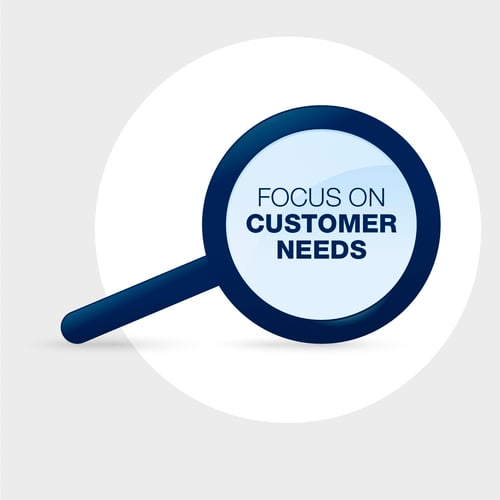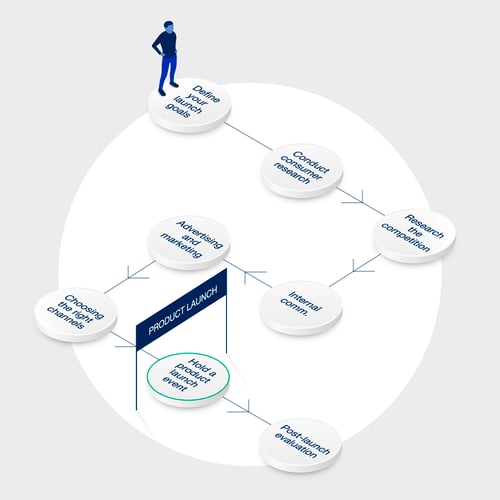Everything you need for your next product launch
Launch your products effectively
Launching a new product is always an exciting moment for a brand. But without proper planning of a go-to-market strategy, strong communication internally and with your target audience, and ample time and resources to commit to prelaunch and postlaunch marketing and advertising, even some of the best products face the risk of failing. That’s why it’s imperative that you develop a product launch strategy.
If you want to avoid common mistakes and make your next product launch more stress-free, take a look at the recording of our latest live talk. We covered everything from the pitfalls of product launches to effective pain-relievers and upcoming trends.
Challenges that threaten successful product launch
The Marketing Research Association states that only 40% of developed products actually make it to market. Of those, only 60% generate positive revenue. As an established brand, you may have already experienced a failed product launch. You can certainly learn from your mistakes and take the proper steps to mitigate potential risks with future product launches. But first, you must understand the common challenges most product launches face.

Timing
Timing is a critical factor. You cannot rush a product launch before everything is ready, nor can you wait too long and miss out on a marketing opportunity. That’s why you need to start preparing for your product launch many months in advance, using consumer data, surveys, analytics, and other forms of testing.
Customer preferences will also dictate the perfect timing for your product launch. Launching a product that perfectly coincides with a time the market desires it most will greatly improve the chances of success.
At the same time, you want to ensure that the quality of the product has not suffered just so you could release it at a certain time. Additionally, marketing and advertising must align with your target go-to-market date.
And lastly, what are your competitors doing? Are they releasing a product similar to yours? That could also affect the success of your product.
Advertising and marketing
A lack of proper marketing and advertising is another major reason product launches fail. Before launching your product, you need to identify consumer needs and pain points, discover what channels are optimal to advertise the product, and determine what type of messaging will resonate best with your audience.
Consumer needs
Understanding consumer needs is vitally important to the success of a product launch. Consider the customer journey. What touchpoints does the customer come across when researching your brand. Put yourself in the customer’s shoes and see where your own journey might lead you. This will better help you to identify failed touch points and make the necessary adjustments to better speak to and guide the consumer along the right path to a sales conversion.

Market and pricing
Many products fail simply because companies focus on the wrong market. Additionally, many brands fail to price the product based on the relationship between consumer demand, need and the ultimate value of the product. There are dozens upon dozens of factors to consider when launching a new product, and only with the development of a strong plan can you hope to achieve sales success. In fact, many experts state that it doesn’t matter how good your product is — without a strong product launch, there is little chance of success.
Developing Your Product Launch Strategy
First, focus on the development of the plan
- Define your launch goals. Defining your goals, and following that, considering your target audience, lays the initial groundwork for your product launch strategy.
- Conduct consumer research. You need to know what features your customers will appreciate the most. You need to know which marketing channels they will be most receptive to. And you need to know how to tell a story with your product launch marketing that will resonate with them.
- Research the competition. Without being aware of competitor products and marketing efforts, you may end up launching a product or conducting a marketing campaign that just isn’t on the same level as a competitor.

Be sure not to falter on the internal communication
Communication is always an integral component of any business function and planning strategy. Several departments will play roles in the product launch, and they all need to be able to communicate effectively with each other throughout the planning stages. Keeping everyone on the same schedule and making sure everyone within the organization understands the messaging and goals will help increase the likelihood of success for your product launch strategy.

Consider your advertising
Creating a marketing plan can be just as intensive and time-consuming as developing the overall product launch strategy. The story of the product should explain to consumers why they need the product and why they should choose your product over the competition. Stay focused on customer pain points and product benefits, and you’ll be truer to the development of a viable marketing strategy that showcases your product without focusing too much on selling the product.

Holding a product launch event may be a great way to go to market
Holding a product launch event serves to build awareness as well as generate buzz and anticipation during the prelaunch efforts. You might also want to consider holding a virtual event as opposed to a physical event.
Tips for product launch
Leave yourself plenty of time to develop your product launch strategy and at least four to six months to plan for a product launch event.
Create a product launch roadmap that defines your goals, lays out the plan for your strategy, and assigns tasks to the various teams and individuals in your organization that will take part in implementing the launch.
Time your internal communications so that different teams know what they need to know at the right time and aren’t overwhelmed with an abundance of information all at once.
Remember to include ample information about the benefits of the product to each department.
Make sure your marketing and advertising teams are communicating with each other and are focused on delivering the same messaging.
What are their pain points? Create your own unique selling proposition (USP) based on customer needs, the competitor's product offerings, the benefits delivered by your own product, and the value of your brand promise.
Use social media platforms and other forums to engage with your customers consistently, so you can learn how they feel about your brand and your products.
Make sure you use the right channels for your advertising and internal communications.
For a product launch event, plan a theme, setting and entertainment that make sense for your industry. It should also be uplifting, inspirational and innovative.
Follow up with your audience after the product launch event.
Gather feedback from different teams, so you can see what you may want to improve for future product launches.
Technology to enhance your product launch
Several advanced and intuitive technological tools can help raise your product launch event to the next level and provide a great experience for your audience. This is especially true for virtual product launch events where an audience of thousands can tap into the buzz and excitement of a shared online experience.
Digital and Virtual Showroom
Virtual launches can be extremely engaging, and today’s ever-advancing technology gives brands the capability to provide unique and interesting settings for their products. Consider for example digital and virtual showrooms. With innovative sales tools, you can invite your audience to interact with your products in a captivating manner.
Social Media Videos
Social media videos are also ideal for advertising. Social media films captivate the audience with compelling stories and stunning visuals, building buzz and anticipation about your product launch.
Assembly Animation Videos
To aid in internal communication efforts, you can utilize assembly animation films. These advanced visual tools provide your teams with an informative and engaging resource that enables them to better understand the product and its features.
WebAR
Augmented reality can be used as a truly unique sales tool, allowing customers to easily visualize how a product will look within their own homes to build the buzz during the product launch.
VR
Virtual reality can take your product launch event to a new level by offering a unique experience to your participants. By seeing your product in virtual reality, users can understand the benefits quicker and you take care of the entertainment as well.
Take the next step with video marketing
Discover some of the possibilities CGI offers for video marketing. If you are unsure of how video can play a role in your product launch, gain inspiration from our clients below.
Don’t forget that once you’re up and running with any form of 3D visualization, it’s easy to reuse for other types of CGI such as images, VR, AR, or different product configurators.
Top business videos

This video produced for Linn bad presents a beautiful bathroom with a focus on design, quality, and functionality.

We created this video for Nobia for use on their social media platforms. The video presents just one of their many beautiful kitchen brands.

“You are in good hands with Cadesign – they are innovative, visionary, friendly, solution-oriented and an amazing sounding board. You are definitely a front-runner if you choose them! I would not be without them.” Mia Thøisen, Egernsund Wienerberger.

We have had the pleasure of producing this assembly film for Magnet, which explains how their kitchen cupboards are assembled.

In this animation film that we have produced for Raptor Services, we get insights into how companies can boost their sales with the Raptor Smart Advisor.

We created this animation film for Schur Star Systems, which show one of the world’s most flexible packaging solutions.
Let the technology do the hard work
Spend your time on what you like the most; getting creative, minimizing lead time on marketing assets, or plain and simple free up more time in your schedule. Let the technology do the hard work.
Helpful video marketing resources
We've collected a list of some of the resources out there that we found very useful. If you feel something is missing, don't hesitate to reach out to us either on the chat or by email.
List of resources
Mastering Value Propositions (Strategyzer)
How to create a detailed buyer persona for your business (HubSpot)
The changing meaning of sustainable (Furniture World)
What is an omnichannel customer experience? (Acquire)
Video Marketing: The ultimate guide to getting started (Cadesign form)
Examples from your industry
Go to our industry-specific pages where we've collected all the best images, films, and product configuration examples from four different industries: Furniture, Kitchen & Bath, Home Improvement, and Industry & Manufacturing.

Conclusion
A comprehensive product launch strategy requires a lot of time, communication, and resources. It’s also important to remember that no two product launches will ever be the same. Each product launch will likely face its own specific challenges, as well as the common challenges that are always present, such as economic factors, changing consumer wants and needs, and what the competition is doing.
No product launch strategy will ever be finalized, either. Be prepared to make numerous changes along the way and to adjust your plan in accordance with sudden changes in the marketplace. At the same time, you should seek input from team members within your organization, especially if you are customer-centric. With the mindset of providing the best possible service and customer experience for your target market, your employees may have keen ideas on how to improve your product launch strategy and the related messaging of your marketing campaign.
Finally, always leave yourself plenty of time for research, planning and sales forecasting. With clearly defined goals, a strong understanding of the customer, and a keen eye on the marketplace, you’ll be well-equipped to put together a product launch strategy that has a strong chance of success.

















